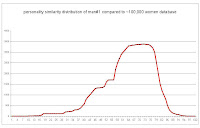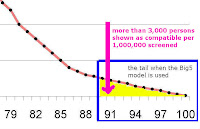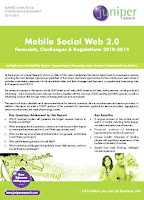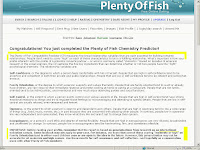A Match Made In Silicon: Marriage Matching Algorithms for Dynamic Microsimulation
part of the DYNACAN project, a full-fledged Canadian actuarial stochastic model designed for the fiscal and policy analysis of social security schemes.
DYNACAN was a Canadian, stochastic (Monte Carlo), open, longitudinal, dynamic microsimulation model developed for generating longitudinal and cross-sectional, as well as fiscal and policy-oriented analyses of Canadian Social Security Schemes such as the Canada Pension Plan (CPP), the Old Age Security (OAS) Program and the Guaranteed Income Supplement (GIS).
Marriage and Remarriage: This module had two sub-components.
First, each simulation year, it identifies appropriate numbers of persons, separately by gender, as being "in the marriage market." The probability of entering the pool depends on a person's characteristics, e.g. age, education, earnings level, marital status (never-married, separated, divorced, widow(er)ed) and the presence of dependent children. Second, using a compatibility index based on the individuals' characteristics, the module serves as "matchmaker" to create
specific couples from the gender-specific pools of individuals in the market that simulation year. We align marriage and remarriage rates using Statistics Canada vital statistics information on the age and gender-specific fractions of people marrying in a given year, and some U.S. data from CORSIM where Canadian data are not available.
The compatibility measure employed by DYNACAN is a logit equation that includes the difference in the individuals' ages and its square, the difference in their years of education, the number of children the woman has, race, labour force participation, and the difference in their earnings. The equations also calculate various interaction effects between variables, such as the male's education if he is the older of the two, and the product of the female's education and the male's earnings.
It is defunct now, and I think it was because the compatibility equation DOES NOT include personality traits, nor any kind of "similarity" calculation in personality traits.
http://www.microsimulation.org/IMA/Ottawa_2009/Papers/Leblanc,%20Neal.pdf
http://www.microsimulation.org/IMA/Ottawa_2009/Presentations/Leblanc,%20Neal.ppt
Monday, May 31, 2010
Saturday, May 29, 2010
Compatibility Distribution curves


I use "personality similarity distribution" for LIFEPROJECT METHOD because it offers strict personality similarity using the 16PF5 and the quantitative method I had invented but other proposals should use "Compatibility Distribution"
Y axis: number of persons per interval (women in this case)
X axis: 100 intervals, from 1 to 100, meaning (n-1).00000000% to (n-1).99999999% of personality similarity with man#1 in interval n.
Eg: In the personality similarity distribution of man#1 compared to ~100,000 women database
There are 1,320 women with 46.00000000% to 46.99999999% of personality similarity with man#1 in interval 47.
There are 3,370 women with 72.00000000% to 72.99999999% of personality similarity with man#1 in interval 73.
There are 500 women with 84.00000000% to 84.99999999% of personality similarity with man#1 in interval 85.
Y axis: number of persons per interval (women in this case)
X axis: 100 intervals, from 1 to 100, meaning (n-1).00000000% to (n-1).99999999% of personality similarity with man#1 in interval n.
Eg: In the personality similarity distribution of man#1 compared to ~100,000 women database
There are 1,320 women with 46.00000000% to 46.99999999% of personality similarity with man#1 in interval 47.
There are 3,370 women with 72.00000000% to 72.99999999% of personality similarity with man#1 in interval 73.
There are 500 women with 84.00000000% to 84.99999999% of personality similarity with man#1 in interval 85.

Friday, May 28, 2010
PAPER Personality and Marital Surplus
Personality and Marital Surplus (DOES NOT check any type of personality similarity between spouses and DOES NOT distinguish between legal marriage and cohabitation—both are
termed "marriage")
"The main independent variables are the Big Five personality traits—openness to experience, agreeableness, extraversion, neuroticism, and conscientiousness.
If we compare the original West German sample with the East German sample added in 1990, the means of most personality traits are not significantly different, though these populations have been subject to very different social and economic environments since childhood. "
See results on page 20, tables 4a Full Sample, 4b Old Cohorts, 4c Young Cohorts for a probit model of marriage.

"Conclusions
Evidence from the German Socio-economic Panel Study shows that several dimensions of personality are strongly associated with the propensity of men and women to marry and to divorce.
For younger cohorts, born between 1960 and 1970, two personality traits (LOW openness to experience and HIGH conscientiousness) have essentially identical effects on the probability of marriage by age 35.
Data and Measures
The study uses data from the German Socio-economic Panel Study (SOEP), a representative longitudinal survey of households and individuals in Germany. The initial wave of the survey was conducted in 1984, and consisted of 12,000 randomly-selected respondents in West Germany in 1984. In 1990, following re-unification, a sample from East Germany was added, followed by a sample of immigrants in 1994. Several additional samples have been added in subsequent years, and sample weights are used in all analyses.
The sample is derived from the Scientific Use File of SOEP, and consists of 7,106 household heads, spouses, and partners aged 35 to 59 in 2005. Analysis was conducted on the full sample and separately on two birth cohorts—men and women born between 1945 and 1959, and those born between 1960 and 1970. "
compare the above paper with this poster
Personality Correlates of Different Romantic Intentions in Speed-Daters

112 participants (55 male, 57 female; mean age= 21.97 years SD= 3.16) attended an experimental speed-dating session consisting of a series of speed-dates.
Participants indicated the type(s) of romantic interaction they were currently seeking, including casual sex (n= 24), dating (n=92), committed relationship (n=75), or marriage (n=28).
They then completed self-ratings on the Big Five and other personality traits (e.g., athleticism, wealth and intelligence).
termed "marriage")
"The main independent variables are the Big Five personality traits—openness to experience, agreeableness, extraversion, neuroticism, and conscientiousness.
If we compare the original West German sample with the East German sample added in 1990, the means of most personality traits are not significantly different, though these populations have been subject to very different social and economic environments since childhood. "
See results on page 20, tables 4a Full Sample, 4b Old Cohorts, 4c Young Cohorts for a probit model of marriage.

"Conclusions
Evidence from the German Socio-economic Panel Study shows that several dimensions of personality are strongly associated with the propensity of men and women to marry and to divorce.
For younger cohorts, born between 1960 and 1970, two personality traits (LOW openness to experience and HIGH conscientiousness) have essentially identical effects on the probability of marriage by age 35.
Data and Measures
The study uses data from the German Socio-economic Panel Study (SOEP), a representative longitudinal survey of households and individuals in Germany. The initial wave of the survey was conducted in 1984, and consisted of 12,000 randomly-selected respondents in West Germany in 1984. In 1990, following re-unification, a sample from East Germany was added, followed by a sample of immigrants in 1994. Several additional samples have been added in subsequent years, and sample weights are used in all analyses.
The sample is derived from the Scientific Use File of SOEP, and consists of 7,106 household heads, spouses, and partners aged 35 to 59 in 2005. Analysis was conducted on the full sample and separately on two birth cohorts—men and women born between 1945 and 1959, and those born between 1960 and 1970. "
compare the above paper with this poster
Personality Correlates of Different Romantic Intentions in Speed-Daters

112 participants (55 male, 57 female; mean age= 21.97 years SD= 3.16) attended an experimental speed-dating session consisting of a series of speed-dates.
Participants indicated the type(s) of romantic interaction they were currently seeking, including casual sex (n= 24), dating (n=92), committed relationship (n=75), or marriage (n=28).
They then completed self-ratings on the Big Five and other personality traits (e.g., athleticism, wealth and intelligence).
Thursday, May 27, 2010
PlentyOfFish and Birth Order Item
PlentyOfFish is now asking 2 new questions:
"When you were a kid your perception of love and how you perceive love was shaped by your parents and your siblings.
We want to dramatically improve our matching system by taking into account your childhood environment, Please enter the following."

My birth father and mother are:
Still Married
Divorced
Seperated (I had copied it exactly)
One died
Both died
Not Together

and they had
1 Child
2 Children
3 Children
4 Children
5 Children
6 Children
7 Children
8 Children
9 Children

together of which I am
oldest
second born
third born
fourth born
fifth born
sixth born
seven born
eight born
ninth born

When it comes to dating what best describes your intent?
1. I'm looking for Casual dating/No Commitment.
2. I want to date but nothing serious.
3. I want a relationship.
4. I am putting in serious effort to find someone.
5. I am serious and I want to find someone to marry.

"Update my Birth Order"
Soon the brains at the new PlentyOfFish test will discover that including the Birth Order Item is useless at all, a complete waste of time, it adds more "noise than signal" to the predictor they are tuning.
If you are using PlentyOfFish, have you noticed the misspellings made by Mr. Frind?
If he can make those kind of mistakes typing words, what kind of mistakes does he make in math formulas?
 (this screenshot from Jan2008)
(this screenshot from Jan2008)
See also the welcome message. Nobody is going to take PlentyOfFish for serious dating.
"When you were a kid your perception of love and how you perceive love was shaped by your parents and your siblings.
We want to dramatically improve our matching system by taking into account your childhood environment, Please enter the following."

My birth father and mother are:
Still Married
Divorced
Seperated (I had copied it exactly)
One died
Both died
Not Together

and they had
1 Child
2 Children
3 Children
4 Children
5 Children
6 Children
7 Children
8 Children
9 Children

together of which I am
oldest
second born
third born
fourth born
fifth born
sixth born
seven born
eight born
ninth born

When it comes to dating what best describes your intent?
1. I'm looking for Casual dating/No Commitment.
2. I want to date but nothing serious.
3. I want a relationship.
4. I am putting in serious effort to find someone.
5. I am serious and I want to find someone to marry.

"Update my Birth Order"
Soon the brains at the new PlentyOfFish test will discover that including the Birth Order Item is useless at all, a complete waste of time, it adds more "noise than signal" to the predictor they are tuning.
If you are using PlentyOfFish, have you noticed the misspellings made by Mr. Frind?
If he can make those kind of mistakes typing words, what kind of mistakes does he make in math formulas?
 (this screenshot from Jan2008)
(this screenshot from Jan2008)See also the welcome message. Nobody is going to take PlentyOfFish for serious dating.

Wednesday, May 26, 2010
PAPERS: Genes, Economics, and Happiness
Genes, Economics, and Happiness



Abstract
Research on happiness has produced valuable insights into the sources of subjective well-being. A major finding from this literature is that people exhibit a baseline happiness that shows persistent strength over time, and twin studies have shown that genes play a significant role in explaining the variance of baseline happiness between individuals.
However, these studies have not identified which genes might be involved.
This article presents evidence of a specific gene that predicts subjective well-being.
Using data from the National Longitudinal Study of Adolescent Health, we show that individuals with a transcriptionally more eficient version of the serotonin transporter gene (5HTT) are significantly more likely to report higher levels of life satisfaction.
Having one or two alleles of the more eficient type raises the average likelihood of being very satisfied with one's life by 8.5% and 17.3%, respectively. This result may help to explain the stable component of happiness and suggests that genetic association studies can help us to better understand individual heterogeneity in subjective well-being.



Abstract
Research on happiness has produced valuable insights into the sources of subjective well-being. A major finding from this literature is that people exhibit a baseline happiness that shows persistent strength over time, and twin studies have shown that genes play a significant role in explaining the variance of baseline happiness between individuals.
However, these studies have not identified which genes might be involved.
This article presents evidence of a specific gene that predicts subjective well-being.
Using data from the National Longitudinal Study of Adolescent Health, we show that individuals with a transcriptionally more eficient version of the serotonin transporter gene (5HTT) are significantly more likely to report higher levels of life satisfaction.
Having one or two alleles of the more eficient type raises the average likelihood of being very satisfied with one's life by 8.5% and 17.3%, respectively. This result may help to explain the stable component of happiness and suggests that genetic association studies can help us to better understand individual heterogeneity in subjective well-being.
Monday, May 24, 2010
featured in Mobile Juniper Research
I am featured in the Latest Mobile Social Web 2.0 Forecasts, Challenges & Regulations 2010-2014 from Juniper Research.

Here is the link
http://www.juniperresearch.com/reports/mobile_social_web_2.0

Here is the link
http://www.juniperresearch.com/reports/mobile_social_web_2.0

"Overview
As the first part of Juniper Research's focus on mobile web 2.0 this report establishes the industry benchmark for investigative analysis providing the most detailed appraisal yet published of the current and future opportunities for the mobile social web market. It provides an extensive assessment of industry stakeholders and their strategies and features a comprehensive forecasting suite for five years up until 2014."
3.2.4 Cultural Influences
ii. Mobile Dating page49
screenshot.

This report was written by Ian Chard.
Etiquetas:
dating,
Juniper Research,
mobile
Saturday, May 22, 2010
PlentyOfFish Screenshots
About "PlentyOfFish can now predict who you will marry."




It is an improvement but not an innovation. Frind only adjusted the output of the algorithm.
Before that adjustment the algorithm was an "out of control machine gun" firing flowers, and now it only shoots 30 "flowers" per dater without showing a compatibility percentage any more.
At PlentyOfFish there are 3 tests, and they are still the same as before.
1) PlentyOfFish Relationship Chemistry Predictor (POFCP) [measures five broad dimensions of personality that are each essential for building a romantic relationship]
It is a proprietary FLAWED Big5 model to assess personality.





It is FLAWED because that personality test should be:
- in English for the United States and the Norm for the United States (sample of individuals with the same demographic characteristics of the United States).
- in English/French for Canada and the Norm for Canada (sample of individuals with the same demographic characteristics of Canada)
- in English for the United Kingdom and the Norm for the United Kingdom (sample of individuals with the same demographic characteristics of the United Kingdom).
- in English for Australia and the Norm for Australia (sample of individuals with the same demographic characteristics of Australia).
and so on for each & every country where PlentyOfFish is available.
2) PlentyOfFish Relationship Needs Assessment
Compatibility at PlentyOfFish is all about personality "similarity".
question #76 "I find that my past partners and I usually share the same mood."
and
question #78 "My partner is the sort of person whom I myself would like to be."



3) PlentyOfFish Integrity, Sincerity and Relationship Stability test.
Only users who can form and maintain long term relationships are given the privilege of upgrading.





Mr. Frind (I suppose he is the one who) answered at his blog "Plenty of fish blog": "All personality tests are BS, including your 16pf5 as well as the big5. We use a completely different approach."
but the "The Plentyoffish Relationship Chemistry Predictor (POFCP) measures five broad dimensions of personality that are each essential for building a romantic relationship."

Before that adjustment the algorithm was an "out of control machine gun" firing flowers, and now it only shoots 30 "flowers" per dater without showing a compatibility percentage any more.
At PlentyOfFish there are 3 tests, and they are still the same as before.
1) PlentyOfFish Relationship Chemistry Predictor (POFCP) [measures five broad dimensions of personality that are each essential for building a romantic relationship]
It is a proprietary FLAWED Big5 model to assess personality.





It is FLAWED because that personality test should be:
- in English for the United States and the Norm for the United States (sample of individuals with the same demographic characteristics of the United States).
- in English/French for Canada and the Norm for Canada (sample of individuals with the same demographic characteristics of Canada)
- in English for the United Kingdom and the Norm for the United Kingdom (sample of individuals with the same demographic characteristics of the United Kingdom).
- in English for Australia and the Norm for Australia (sample of individuals with the same demographic characteristics of Australia).
and so on for each & every country where PlentyOfFish is available.
2) PlentyOfFish Relationship Needs Assessment
Compatibility at PlentyOfFish is all about personality "similarity".
question #76 "I find that my past partners and I usually share the same mood."
and
question #78 "My partner is the sort of person whom I myself would like to be."



3) PlentyOfFish Integrity, Sincerity and Relationship Stability test.
Only users who can form and maintain long term relationships are given the privilege of upgrading.





Mr. Frind (I suppose he is the one who) answered at his blog "Plenty of fish blog": "All personality tests are BS, including your 16pf5 as well as the big5. We use a completely different approach."
but the "The Plentyoffish Relationship Chemistry Predictor (POFCP) measures five broad dimensions of personality that are each essential for building a romantic relationship."


Etiquetas:
Chemistry,
Compatibility,
hoax,
Personality,
PlentyOfFish,
Similarity
Friday, May 21, 2010
PlentyOfFish "NEW" test
At Plenty of fish blog a new post says:


"Plentyoffish can now predict who you will marry.
May 20, 2010 by Markus
After years of collecting data and trying all kinds of things to predict who will fall in love, who will break up and who will marry we have finally done it. We now have a fairly accurate model for predicting who an average user will end up with. Obviously it won’t work for everyone, but what predictive statistical model does?
This new model completely replaces our old chemistry test. We now give you a set of 30 matches that you are most likely going to end up dating. The list will mostly stay the same but it will change if a better match signs up or one of your matches deletes themselves from the site. "
--------------------------------
I had checked this new PlentyOfFish matching algorithm, it does not give you a compatibility percentage any more; and it is still based on a proprietary Big5 model to assess personality traits.
This new PlentyOfFish matching algorithm seems to be the same dog with another collar or the same book with another cover, or the same food with another taste.




and I had asked:
What is exactly new, different or better in this new approach than what the old one offered?
Which is exactly the range of that new PlentyOfFish matching algorithm?
e.g: In a big database as the one at PlentyOfFish, it shows you 3 women per 10,000 women screened or 30 women per 100,000 women screened. (10 times better than the old algorithm)???
As Marital Stability does not include Marital Satisfaction, a marriage can be stable but miserable. Can you show this new PlentyOfFish matching algorithm can match prospective partners who will have more stable and satisfying relationships than couples matched by chance, astrological destiny, personal preferences, searching on one's own, or other technique as the control group in a peer reviewed Scientific Paper?
Is Dr. James Houran the brain behind this new PlentyOfFish matching algorithm?
If you are so rich, why don't you acquire the license of the 16PF5 normative personality test instead of still using a proprietary Big5 model to assess personality?
WorldWide, there are over 5,000 (five thousand) online dating sites, but no one is using the 16PF5 normative personality test, available in different languages to assess personality of their members, or a propietary test with exactly the same traits of the 16PF5
Mr. Frind (I suppose he is the one who) answered

"All personality tests are BS, including your 16pf5 as well as the big5.
We use a completely different approach."
but at http://www.plentyoffish.com/poftest.aspx says:

"The Plentyoffish Relationship Chemistry Predictor (POFCP) measures five broad dimensions of personality that are each essential for building a romantic relationship. "
Is it a case of schizophrenia?


"Plentyoffish can now predict who you will marry.
May 20, 2010 by Markus
After years of collecting data and trying all kinds of things to predict who will fall in love, who will break up and who will marry we have finally done it. We now have a fairly accurate model for predicting who an average user will end up with. Obviously it won’t work for everyone, but what predictive statistical model does?
This new model completely replaces our old chemistry test. We now give you a set of 30 matches that you are most likely going to end up dating. The list will mostly stay the same but it will change if a better match signs up or one of your matches deletes themselves from the site. "
--------------------------------
I had checked this new PlentyOfFish matching algorithm, it does not give you a compatibility percentage any more; and it is still based on a proprietary Big5 model to assess personality traits.
This new PlentyOfFish matching algorithm seems to be the same dog with another collar or the same book with another cover, or the same food with another taste.




and I had asked:
What is exactly new, different or better in this new approach than what the old one offered?
Which is exactly the range of that new PlentyOfFish matching algorithm?
e.g: In a big database as the one at PlentyOfFish, it shows you 3 women per 10,000 women screened or 30 women per 100,000 women screened. (10 times better than the old algorithm)???
As Marital Stability does not include Marital Satisfaction, a marriage can be stable but miserable. Can you show this new PlentyOfFish matching algorithm can match prospective partners who will have more stable and satisfying relationships than couples matched by chance, astrological destiny, personal preferences, searching on one's own, or other technique as the control group in a peer reviewed Scientific Paper?
Is Dr. James Houran the brain behind this new PlentyOfFish matching algorithm?
If you are so rich, why don't you acquire the license of the 16PF5 normative personality test instead of still using a proprietary Big5 model to assess personality?
WorldWide, there are over 5,000 (five thousand) online dating sites, but no one is using the 16PF5 normative personality test, available in different languages to assess personality of their members, or a propietary test with exactly the same traits of the 16PF5
Mr. Frind (I suppose he is the one who) answered

"All personality tests are BS, including your 16pf5 as well as the big5.
We use a completely different approach."
but at http://www.plentyoffish.com/poftest.aspx says:

"The Plentyoffish Relationship Chemistry Predictor (POFCP) measures five broad dimensions of personality that are each essential for building a romantic relationship. "
Is it a case of schizophrenia?
Etiquetas:
Compatibility,
hoax,
Personality,
PlentyOfFish
Subscribe to:
Posts (Atom)







